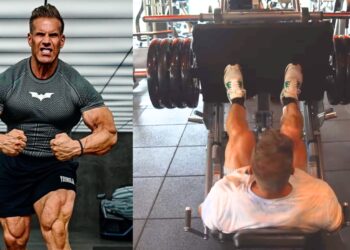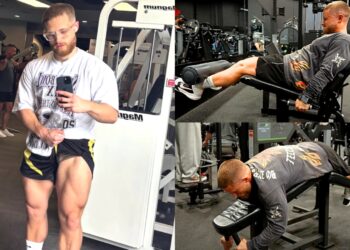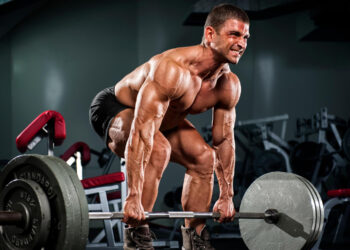Whether you want to build muscle, get crazy-strong, or build a fantastic butt, you need to be deadlifting hard and often. As well as being a tremendous full-body exercise, deadlifts also teach you how to lift hefty objects off the floor safely, by using your legs and without rounding your back.
There are three main types of deadlift you can choose from: conventional deadlifts, sumo deadlifts, and trap bar deadlifts. All three involve lifting a weight off the floor. But just because there are only three recognized types of deadlift, does that mean you limited to using only these variations?
Absolutely not!
There is another way you can do this exercise – from a deficit.
Deficit deadlifts are challenging but will add a whole new element to your training. If you want to take your workouts to a new, higher level, you are going to LOVE deficit deadlifts.
What are deficit deadlifts, and what are the benefits?
Deficit deadlifts involve lifting a weight off the floor while standing on a raised platform. The height of the platform depends on several factors, including how tall you are, the length of your arms, your flexibility, and how much weight you want to lift.
Level Up Your Fitness: Join our 💪 strong community in Fitness Volt Newsletter. Get daily inspiration, expert-backed workouts, nutrition tips, the latest in strength sports, and the support you need to reach your goals. Subscribe for free!
That said, most people use a platform of between one to four inches high. The higher the platform, the harder deficit deadlifts become. Tall lifters usually need a lower platform, while shorter lifters and those with longer arms can usually use a higher one.
Doing deadlifts from a deficit has the effect of increasing your range of motion. In simple terms, you have to bend over more to grab the bar. This means, compared to deadlifts from the floor, the weight travels further per rep. While the extra distance is quite small, it makes deficit deadlifts harder than regular, non-deficit deadlifts.
You can apply the deficit method to all three types of deadlift – sumo, trap bar, and conventional. All you need is a platform to stand on.
Deficit deadlifts have several valuable benefits:
Increased time under tension– increasing the range of motion means that each rep of deficit deadlifts takes a little longer, and that increases your time under tension. This makes each rep more demanding and potentially better for hypertrophy or muscle building. Time under tension, TUT for short, plays an integral part in building bigger muscles (1).
More work for the posterior chain– the posterior chain is the collective name for the muscles on the back of your body. The main posterior chain muscles are:
- Hamstrings– located on the back of your thigh and responsible for hip extension and knee flexion.
- Gluteus maximus– glutes for short, this is the largest muscle in the human body. Located on the back of your hip, this is your main hip extender.
- Erector Spinae– the muscles that make up your lower back. They run the length of your spine in two columns.
The posterior chain is heavily involved in all running and jumping-type activities. Deficit deadlifts are very valuable for athletes looking to boost their strength and power for sport. Bending down into a more flexed position forces these muscles to work much harder than usual. This is good for building both strength and increasing muscle size.
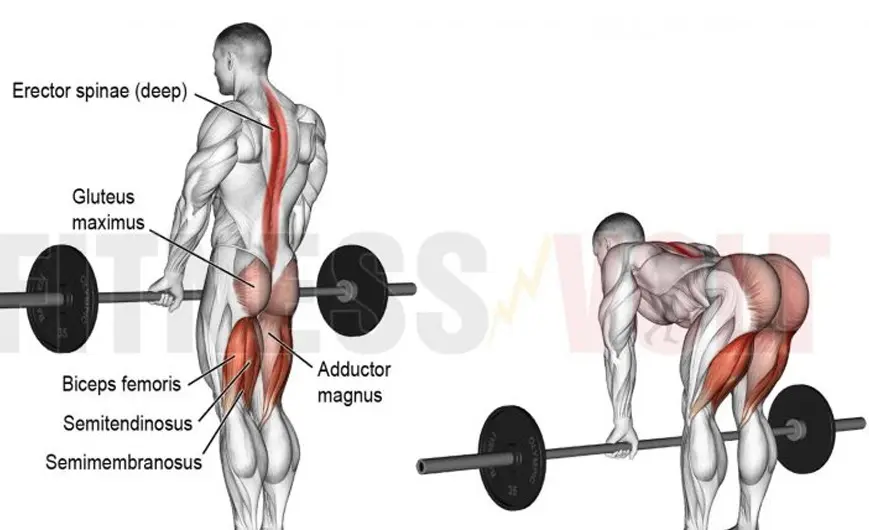
Note: Deadlifts also involve your latissimus dorsi muscles or lats, your upper and mid trapezius or traps, your quadriceps or thigh muscles, your core, and your upper and lower forearms. However, doing deadlifts from a deficit does not have any additional effect on these muscles.
Increased force production– powerlifters use deficit deadlifts to improve their explosiveness off the floor. Strength is important for lifting heavy weights, but so too is power and acceleration. Lifting a weight fast makes it easier to move. Momentum is very valuable. Deficit deadlifts increase starting speed. This will make you more faster and explosive off the floor. Powerlifters often include deficit deadlifts in their training for this reason.
Better, tighter set-up position for regular deadlifts– doing deficit deadlifts teaches you to get low and tight at the start of each rep. Because you have to bend down further, you have no choice but to get really tight at the beginning of each rep. Deficit deadlifts will teach you to adopt a better set up position, and that will have a knock-on effect on your regular deadlifts. If you struggle to get low and tight for regular deadlifts, deficits can help.

Variety– there are three types of deadlifts to choose from, and adding deficits into the mix means you now have six different deadlift variations to use in your workouts. Variety is important for avoiding training plateaus and has been shown to be a critical factor for developing maximal strength and muscle size. In simple terms, more variety will help you make faster progress (2).
How to do deficit deadlifts
To get the most from this or any exercise, while keeping the risk as low as possible, you should always use proper form. Reduce your risk of injury further by practicing new exercises with light weights. Only increase the load when you are sure you have mastered the correct technique.
You can do all three types of deadlift using a deficit, so just make sure you do your chosen deadlift variation properly. To help you with this, let’s go over how to do conventional deficit deadlifts. Before you start, remember to warm up with some light cardio, dynamic stretches, and a few sets of deadlifts with an empty bar.
1. Place your platform on the floor. For your first few sets, stick with something about 1-2 inches high. A 45-pound Olympic weight plate is ideal, or you can use a couple of stacked high-density mats, an aerobic step box top, or something similar.
2. Adopt your normal deadlift stance – normally with your feet between shoulder and hip-width apart. If you are standing on a weight plate, you may need to place two side by side to give you a wide enough platform, putting one foot on either plate.
3. Squat down and grab the bar with a double overhand or alternating grip. Not sure which one to use? Check out our article on grip variations.
4. Lower your hips, lift your chest and straighten your arms. Brace your abs and slightly arch your lower back. You should feel like a tightly coiled spring, ready to explode.
5. Drive your feet into the floor and stand up. Do not let your hips rise faster than your shoulders, and do not round your lower back. Keep your arms straight. At the end of your rep, make sure you are stood fully erect but don’t lean back.
6. Push your hips back and bend your knees. Lower the weight to the floor under control. Don’t just drop it. Because you are standing on raised blocks, it may feel like a long way down to reach the floor. Make sure you stay tight until the bar touches down.
7. Let the weight settle, reset your start position, get tight, and do another rep.
Once you have mastered the deficit deadlift and are ready to add them to your workouts, make sure your rep and weight scheme matches your training goal. Follow these guidelines:
- For strength– 3-5 reps per set, 85%+ of your one-repetition maximum (1RM). Rest 3-5 minutes between sets.
- For hypertrophy– 6-12 reps per set, 67-85% of your 1RM. Rest 60-90 seconds between sets.
- For muscular endurance – 13-20 reps per set with 50-66% of your 1RM. Rest 30-60 seconds between sets.
Common deficit deadlift mistakes to avoid
Done correctly, deficit deadlifts are a brilliant exercise. But, done improperly, they can lead to serious injury. Avoid these common mistakes to make sure you keep your risk of injury to a minimum.
Too big a deficit– the higher your platform, the more likely you are to round your lower back. If you have to bend down a long way, it’s almost unavoidable unless you have the flexibility of an elite gymnast! Start off with a very modest deficit, such as one inch, and then increase gradually over several weeks. Stop increasing the deficit if you are unable to deadlift without rounding your lower back.
Level Up Your Fitness: Join our 💪 strong community in Fitness Volt Newsletter. Get daily inspiration, expert-backed workouts, nutrition tips, the latest in strength sports, and the support you need to reach your goals. Subscribe for free!
Using too much weight– deficit deadlifts make weights feel heavier. Why? Because you have to move the weight further and do more work per rep. Because of this, you don’t need to use the same amount of weight as you do for regular deadlifts. Reduce your training weights by 20-30% and increase gradually over several weeks. As your deficit deadlift strength increases, so too will your regular deadlift strength.
Using the same mixed grip– an alternating or mixed grip will help you lift more weight. It stops the bar from rolling out of your fingers. However, the alternating grip also puts a lot of extra strain on your supinated (palm forward) hand. It could also lead to uneven muscular development. Avoid these problems by switching hands set-by-set. Better still, use a double overhand grip and work on increasing your hand strength.
Letting your hips rise faster than your shoulders– if your hips shoot up more quickly than the weight, you risk putting a lot of extra strain on your lower back and also limiting the amount of weight you can lift. Watch your hips in the mirror or video yourself from the side to make sure your hips and shoulders rise at the same time. Prevent this problem by getting really tight at the start of each rep, bracing your core as hard as you can, and focusing on keeping your chest up.
Leaning back at the top of each rep– a lot of lifters lean back at the top of each rep of deadlifts. This is a big mistake. Leaning back, over-extends your spine, putting a lot of extra stress on your intervertebral disks and lumbar vertebrae. It doesn’t make the exercise any more productive. It just increases your risk of serious injury. Stand up straight at the top of each rep, but don’t lean back.
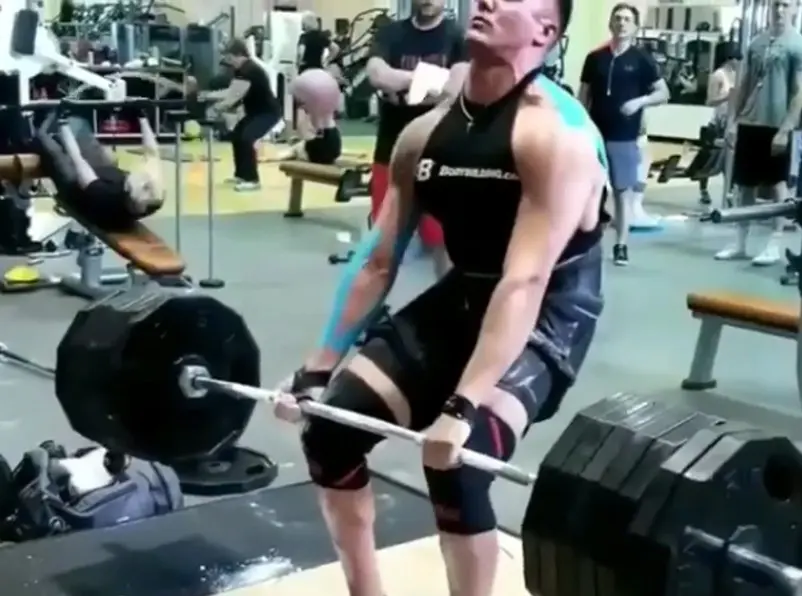
Programming the deficit deadlift
There are several ways to incorporate deficit deadlifts into your workouts.
Make it your only deadlift variation– drop regular deadlifts for a few weeks and focus on deficits. When you return to regular deadlifts, you should find that both your technique and strength have improved.
Use them in a second weekly deadlift workout– if you are serious about improving your deadlift, you may benefit from deadlifting twice a week, e.g., Monday and Thursday. Don’t do the same type of deadlift for both workouts; that’ll soon get boring. Instead, do regular deadlifts for one workout, and deficit deadlifts for the other. This will keep your workouts fresh and fun.
Warm-up with deficits– warming up for regular deadlifts with deficits is an excellent way to prepare your body for what is to come. Deficits feel harder than regular deadlifts, and that means when you ditch your platform and deadlift from the floor, your reps will feel more comfortable.
For example:
Warm-up set 1 – deficit deadlifts 135 lbs x 10 reps
Warm-up sets 2 – deficit deadlifts 175 lbs x 8 reps
Warm-up set 3 – deficit deadlifts 225 lbs x 6 reps
Work set 1 – regular deadlifts 265 lbs x 5 reps, etc.
Because deficit deadlifts involve a more extensive range of motion, they will also increase your mobility and flexibility. You should feel warmer and more supple when it’s time to do your first work set of regular deadlifts.
Alternatives to deficit deadlifts
As good as the deficit deadlift is, there is more than one way to make deadlifts more demanding. Not all gyms have the equipment necessary for deficit deadlifts, and even those that do may not have enough to go around. Some gyms really don’t like it when you stand on their expensive 45-pound bumper plates!
Here are a couple of alternatives to deficit deadlifts that you can do anytime you don’t have a suitable platform to stand on.
Snatch grip deadlifts
Snatch grip deadlifts increase your range of motion not by raising your feet but by placing your hands further apart than usual. This forces you to bend over more to reach the bar. This method only works with conventional deadlifts.
How to Do a Snatch Grip Deadlift:
1. Stand with your toes under the bar and your feet between shoulder and hip-width apart.
2. Squat down and grip the bar with an overhand grip. Your hands should be roughly 1½ shoulder widths apart. Use a double overhand or hook grip; an alternating grip will not work. Feel free to use lifting straps.
3. Lower your hips, lift your chest and straighten your arms. Look straight ahead and brace your core. You are now ready for lift-off!
4. Drive your feet into the floor and stand up straight. Do not bend your arms or round your lower back.
5. Push your hips back, bend your legs, and lower the bar back to the floor. Stay tight throughout the descent. Reset your position and repeat.
Small plate deadlifts
Standard 45-pound Olympic barbell weight plates are 450mm/17.72 inches in diameter. Without a deficit, this means a barbell set up for deadlifts should be about 8.5 inches off the floor. A two-inch deficit means the bar is effectively 6.5 inches above the floor.
If you have no platform to stand on, you can create the same effect by using smaller diameter plates. This method can be used with all three types of deadlift. You’ll need to use more plates to load your bar with the required weight, but that’s better than not being able to do deficit deadlifts just because you don’t have a suitable platform.
The wrap-up
As effective as deadlifts are, they are not the only way to build your posterior chain. There are several alternative exercises you can do instead. That said, if you really want to hammer your glutes, hamstrings, and lower back, boosting your regular deadlift performance at the same time, deficit deadlifts are very tough to beat.
Check your ego at the door; deficit deadlifts are brutal! But, once you get over the shock of how much harder they are then off the floor deadlifts, you will LOVE how effective this exercise is!
References
(1) Burd, Nicholas A; Andrews, Richard J; West, Daniel WD; Little, Jonathan P; Cochran, Andrew JR; Hector, Amy J; Cashaback, Joshua GA; Gibala, Martin J; Potvin, James R; Baker, Steven K; Phillips, Stuart M (January 15, 2012). “Muscle time under tension during resistance exercise stimulates differential muscle protein sub-fractional synthetic responses in men”. The Journal of Physiology. 590 (Pt 2): 351–362. doi:10.1113/jphysiol.2011.221200. ISSN 0022-3751. PMC 3285070. PMID 22106173. https://www.ncbi.nlm.nih.gov
(2) Fonseca, Rodrigo M.; Roschel, Hamilton; Tricoli, Valmor; de Souza, Eduardo O.; Wilson, Jacob M.; Laurentino, Gilberto C.; Aihara, André Y.; de Souza Leão, Alberto R.; Ugrinowitsch, Carlos (2014-11). “Changes in exercises are more effective than in loading schemes to improve muscle strength”. Journal of Strength and Conditioning Research. 28 (11): 3085–3092. doi:10.1519/JSC.0000000000000539. ISSN 1533-4287. PMID 24832974. https://www.ncbi.nlm.nih.gov


